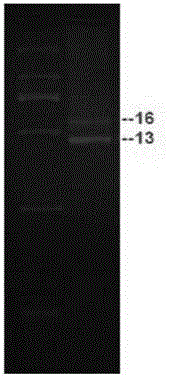Kit for detecting hereditary deafness susceptibility gene mutation
A hereditary deafness and detection kit technology, applied in the biological field, can solve problems such as poor practicality and complicated operation
- Summary
- Abstract
- Description
- Claims
- Application Information
AI Technical Summary
Problems solved by technology
Method used
Image
Examples
Embodiment 1
[0067] Example 1: Negative sample detection
[0068] For the experimental methods without specific conditions indicated in the following examples, conventional conditions are usually followed, such as the molecular cloning operation manual, or the conditions suggested by the manufacturer. All inorganic chemical reagents and organic solvents were purchased from Sinopharm Reagent Co., Ltd., blood DNA extraction kit was purchased from Beijing Quanshijin Biotechnology Co., Ltd., T4DNALigase-E was purchased from New England Biotechnology Co., Ltd., and TransStart TopTaq hot start enzyme was purchased from Beijing Quanshijin Biotechnology Co., Ltd., primers and probes were synthesized by Shanghai Jierui Company. Eppendorf Gradient PCR Amplifier was purchased from Eppendorf, Germany. (1) DNA extraction: Peripheral blood was collected with the consent of the subject or the knowledge of his guardian. The commercially available full-type gold blood DNA extraction kit was used to extra...
Embodiment 2
[0079] Example 2: Blind detection with positive template
[0080] (1) DNA extraction: The artificially synthesized positive DNA containing the mutation point of the detection gene is used as the detection sample.
[0081] (2) Hybridization reaction: According to the amplified bands from small to large, the gene mutation points were marked as 1-16, and random software was used to extract 10 groups of numbers for blind detection.
[0082] Table 3 randomly selected data
[0083]
[0084] (3) According to the extraction number, a positive DNA sample containing a single mutation point corresponding to the extraction number is added to the hybridization reaction system. Add the following components into a 200μl PCR tube, mix well, and react at 65°C for 16h;
[0085] components volume DNA template (10μmol / L) 2μl Each probe (10μmol / L) 0.8μl 1× hybridization solution 7.5μl wxya 2 o Make up to 40μl
[0086] (4) Ligation reaction: add th...
PUM
 Login to View More
Login to View More Abstract
Description
Claims
Application Information
 Login to View More
Login to View More - R&D
- Intellectual Property
- Life Sciences
- Materials
- Tech Scout
- Unparalleled Data Quality
- Higher Quality Content
- 60% Fewer Hallucinations
Browse by: Latest US Patents, China's latest patents, Technical Efficacy Thesaurus, Application Domain, Technology Topic, Popular Technical Reports.
© 2025 PatSnap. All rights reserved.Legal|Privacy policy|Modern Slavery Act Transparency Statement|Sitemap|About US| Contact US: help@patsnap.com



